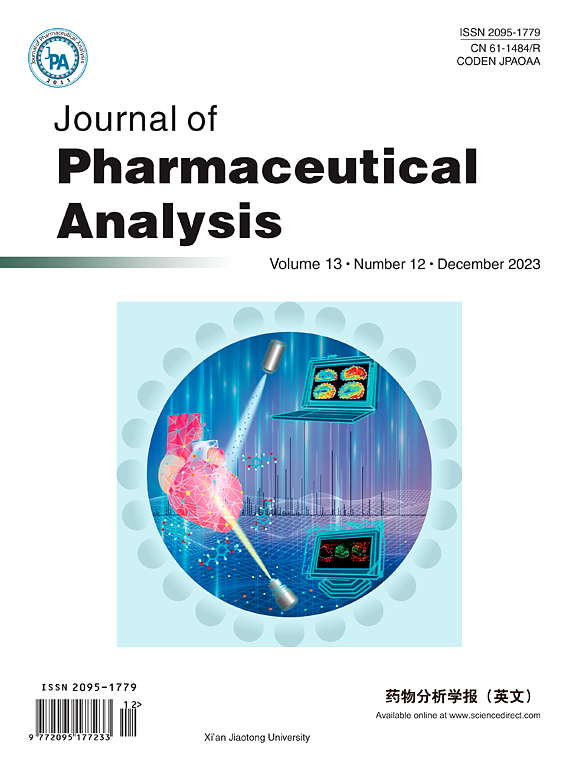局部表面等离子体共振 (LSPR) 和表面增强拉曼光谱 (SERS) 在现代分析中的最新趋势和影响
IF 8.9
1区 医学
Q1 PHARMACOLOGY & PHARMACY
引用次数: 0
摘要
光学生物传感器是一种利用光学原理和光双分子过程的专用分析设备。局部表面等离子体共振(LSPR)是纳米光子学领域的一种现象,当金属纳米粒子(NPs)或纳米结构与入射光相互作用时就会产生这种现象。另一方面,表面增强拉曼光谱(SERS)是一种根植于拉曼散射的有影响力的分析技术,当分子位于特定和特殊设计的纳米结构附近时,它能放大分子的拉曼信号。本文详细探讨了采用 LSPR 和 SERS 技术的光学生物传感器的最新突破性发展及其基本原理和工作机制。我们制作了一个生物传感器芯片,其特点是在不同配体浓度和反应持续时间的情况下,在基底上高密度沉积金纳米粒子。对感应图、折射率偏移、表面等离子体共振(SPR)、蒸发场、瑞利散射、拉曼散射以及电磁增强和化学增强等概念进行了详尽的描述和形象的说明。LSPR 和 SERS 都有各自的优缺点,但广泛使用的 SERS 与 LSPR 相比具有一些优势,如化学特异性、高灵敏度、复用性和在不同领域的通用性。本综述证实并阐明了不同疾病生物标记物鉴定的重要性。LSPR 和 SERS 在检测宫颈癌、卵巢癌、子宫内膜癌、前列腺癌、结直肠癌和脑肿瘤等各种癌症方面都发挥着重要作用。这种拟议的光学生物传感器可用于病毒性疾病、细菌性传染病、真菌性疾病、糖尿病和心脏病生物传感的早期诊断和监测。LSPR 和 SERS 为环境监测、食品安全、提炼水样中的杂质和检测铅提供了新的方向。人们对这些生物传感器的了解仍然有限,而且具有挑战性。本文章由计算机程序翻译,如有差异,请以英文原文为准。
Recent Trends and Impact of Localized Surface Plasmon Resonance (LSPR) and Surface-Enhanced Raman Spectroscopy (SERS) in Modern Analysis
An optical biosensor is a specialized analytical device that utilizes the principles of optics and light bimolecular processes. Localized surface plasmon resonance (LSPR) is a phenomenon in the realm of nanophotonics that arises when metallic nanoparticles (NPs) or nanostructures interact with incident light. On the other hand, surface-enhanced Raman spectroscopy (SERS) is an influential analytical technique rooted in Raman scattering, wherein it amplifies the Raman signals of molecules when they are situated near specific and specially designed nanostructures. A detailed exploration of the recent ground-breaking developments in optical biosensors employing LSPR and SERS technologies has been exhaustively discussed along with their underlying principle and the working mechanism. A biosensor chip has been created, featuring a high-density deposition of gold nanoparticles under varying ligand concentration and reaction duration on the substrate. An ordinary description, along with a visual illustration, has been thoroughly provided for concepts such as a sensogram, refractive index shift, surface plasmon resonance (SPR), and the evanescent field, Rayleigh scattering, Raman scattering as well as the electromagnetic enhancement & chemical enhancement. LSPR and SERS both have their advantages and disadvantages but widely used SERS has some advantages over LSPR like chemical specificity, high sensitivity, multiplexing, and versatility in different fields. This review confirms and elucidates the significance of different disease biomarker identification. LSPR, and SERS both play a vital role in the detection of various types of cancer like cervical cancer, ovarian cancer, endometrial cancer, prostate cancer, colorectal cancer, and brain tumors. This proposed optical biosensor provides potential application for early diagnosis and monitoring of viral disease, bacterial infectious diseases, fungal diseases, diabetes, and cardiac disease biosensing. LSPR and SERS provide a new direction for environmental monitoring, food safety, refining of impurities from water samples, and detection of lead. The understanding of these biosensors is still limited and challenging.
求助全文
通过发布文献求助,成功后即可免费获取论文全文。
去求助
来源期刊

Journal of Pharmaceutical Analysis
Chemistry-Electrochemistry
CiteScore
16.20
自引率
2.30%
发文量
674
审稿时长
22 weeks
期刊介绍:
The Journal of Pharmaceutical Analysis (JPA), established in 2011, serves as the official publication of Xi'an Jiaotong University.
JPA is a monthly, peer-reviewed, open-access journal dedicated to disseminating noteworthy original research articles, review papers, short communications, news, research highlights, and editorials in the realm of Pharmacy Analysis. Encompassing a wide spectrum of topics, including Pharmaceutical Analysis, Analytical Techniques and Methods, Pharmacology, Metabolism, Drug Delivery, Cellular Imaging & Analysis, Natural Products, and Biosensing, JPA provides a comprehensive platform for scholarly discourse and innovation in the field.
 求助内容:
求助内容: 应助结果提醒方式:
应助结果提醒方式:


